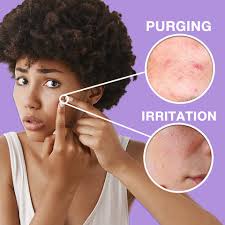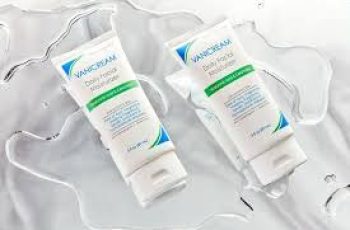
What is Skin Purging and Is It Different than Acne?
Skin purging is a term that is often used to describe an acne breakout that happens after beginning new skincare products, isotretinoin, or after laser, or an acne facial.
Dermatologists like me do not use the word skin purge-we call this an acne flare. There is no difference scientifically between an acne break out and skin purging. The term skin purge is usually used to mean when acne flares after starting a new medication like isotretinoin (Accutane) or other retinoids, however, the term is also used when you break out after laser treatments or a facial.
The definition of “skin purging” is to remove or get rid of something unwanted on the skin. The skin naturally purges itself every day in a process called desquamation- but this is not what you mean when you talk about the “skin purging process”. What you and most people mean when you say your skin is purging is that you are having a sudden rapid acne breakout. The real question here is not the definition of skin purging- rather it is “Is skin purging good for your skin?” In other words, does skin purging make acne go away faster?
What Does It Look Like?
Skin purging looks like acne: both have red bumps or pustule (pimples) on the skin.
Whiteheads and blackheads are not caused by purging- in fact, purging clears whiteheads and blackheads. In fact, the main difference between purging and an acne break-out is the presence or absence of comedones (whiteheads, blackheads, and milia).
When Does It Start?
Skin purging begins within 2-4 days of getting a laser, microneedling, dermaplaning, or an acne facial.
It usually begins within 7 days of starting a new skin care product but m ay take 2 weeks to begin.
Is Skin Purging Good?
It is annoying and embarrassing and can be avoided. Skin purging is common but not normal. It means that the hair follicle is inflamed and not desquamating properly.
Lets divide skin purging into two types to see if either type has benefits.
Purging after Medication
There is no benefit to skin purging unless you are beginning an acne medication and you want to clear the skin faster. If you choose to use weaker acne products, you will have less skin purging, but overall it will take longer for acne to clear. So- if you want to get rid of acne fast, plan to experience some purging.
Purging often occurs after oral and topical retinoids. Your doctor may start you on a lower isotretinoin (Accutane) dose to avoid this- especially if you are at a higher risk of purging. (5)
You can avoid acne flares by starting on lower retinoid dose.
Purging After a Cosmetic Procedure or Treatment
Treatments such as a facial, dermaplaning, radiofrequency, microneedling, chemical peels, and ablative laser like the Fraxel all can cause purging. This occurs due to:
Damage to the hair follicle during the treatment.
Clogging of pores from something comedogenic that was placed on the skin after the treatment
In these situations, skin purging is not good. You should not be having acne flares after facials, microneedling and other procedures.
The Science of Skin Purging
The term skin purging describes the speeding up of an important natural process in the skin called desquamation or keratinization.
The desquamation process also occurs inside the lining of the hair follicles (also called pores). When the desquamation process inside the pores is sped up acne happens faster than normal.
Skin purging means that the regular cell cycle is sped up by skincare products. In other words, whatever was going to happen to your skin happens sooner than it would without the skincare products. Pimples that would have appeared on your skin’s surface in 6-8 weeks will now appear much faster. Purging usually occurs 2-4 weeks after starting a new acne clearing skincare routine but sometimes it can as early as a day. It depends upon what stage of acne the hair follicle was in when the new skincare product was started.
Skin Purging vs Acne Breakout
Skin Purging Versus Breakout
There are many articles online discussing the difference between skin purging and acne breakout. The only way to tell the difference is if you started using new exfoliating skincare products on your skin that speed the cell cycle- then it is most likely purging.
If you have not recently (in the last 2 weeks) started any new skincare products containing retinoids, hydroxyacids and exfoliants, then it is a breakout. The best way to tell the difference between purging and a breakout is that with purging you should not see an increase in comedones (blackheads and whiteheads) and with new acne breakouts you will see clogged pores.
How To Get Clear Skin Without Purging?
The key to avoiding purging is to start with a low-strength retinoid and do not use hydroxy acids or other exfoliating ingredients at the same time.
Slowly increase the retinoid strength each month by following these retinoid instructions.
In general- the more exfoliating products you use- the more purging you will experience.
The best skincare routine to prevent purging really depends upon what your Baumann Skin Type is.
Take the Quiz
How long does skin purging take?
How Long Does It Take To Purge The Skin?
How long skin purging lasts depends on your individual skin turnover time (also called keratinization) takes 52-75 days in human skin. On average the purging process takes 4- 8 weeks. How long purging lasts depends upon many factors like age, health, diet and use of skincare products. That means that it takes an average of 2 months for skin to purge and acne flare to stop.
How to speed up skin purging
How To Speed Up Skin Purging?
Ingredients that stimulate the skin stem cells to divide faster will speed up skin purging.
The best skincare ingredients to speed purging are exfoliants:
alpha hydoxy acids (AHAs) like glycolic acid
ascorbic acid
beta hydroxyacids (BHA) like salicylic acid
defensins
EGF
retinoids
What Skin Care Ingredients Cause Acne Purging Of The Skin?
which skin care products cause purging
Retinoids
The most common skincare ingredients to cause acne purging are retinoids like retinol, tretinoin (Retin A), trifarotene (Aklief), tazarotene (Tazorac), adapalene (Differin). How long will purging last on Retin A, tretinoin, Tazorac and other retinoids depends upon skin type, the other products in the acne skincare routine, and the retinoid percentage strength. The
retinol purging period for Accutane depends upon how many mg of Accutane per kg of body weight is prescribed. Basically- weaker retinoids will purge less severely but for longer while the retinol purging period of stronger retinoids will be worse but shorter.
Vitamin C
Vitamin C, also called ascorbic acid, is a mild exfoliant and can cause mild skin purging.
Hydroxy Acids, AHA, Glycolic Acid
The AHA purging period depends upon the strength of the AHA, the type of AHA, the pH of the AHA products and what other skincare products are in the skincare routine. This is why it is best to have a customized skincare routine based on your skin type. You can learn more about customized dermatologist recommended skin care routines here.
Niacinamide
Niacinamide does not cause skin purging, exfoliation or acne.
BHA and Salicylic Acid
Salicylic acid is an example of a BHA. It is the best hydroxyacid to treat skin purging because salicylic acid is lipophilic and can penetrate through sebum in the pores. This helps eliminate whiteheads and blackheads and speed purging. Salicylic acid is also anti-inflammatory and helps prevent inflammation and pigmentation.
How to Treat Skin Purging?
When skin is purging, there are a few things you can do. Don’t pick. Use anti-inflammatory ingredients. Cut down your exfoliants to only 1 or 2 a day. Reduce sugar and dairy from the diet which are known to cause acne flares., cover with a noncomedogenic makeup foundation with SPF to prevent post inflammatory hyperpigmentation.
Ingredients to treat purging skin
What Is The Best Skin Care Ingredient To Treat Acne Purging?
Salicylic acid can get down inside the hair follicles and remove a lot of the desquamated loose skin cells. Removing these dead skin cells that clog pores will decrease the risk of skin purging. Salicylic acid also helps soothe the skin and reduce inflammation.
A Salicylic acid cleanser combined with retinoids can help reduce the purging seen with retinoids. SA reduces inflammation, speeds the cell cycle and clears pores.
Start with low-strength retinoids as part of your skincare routine. Take the quiz to learn what retinoids are best for your skin type. Here are examples of low-strength retinoids.
How to Plan for Skin Purging?
My advice is to look at your social schedule and see when the best time to have a breakout is. How you use your retinoid will determine how much purging you get and how many retinoid side effects you will experience.
If you need to look great in 4-5 weeks, then suffer through the acne purging as fast as possible and let the cell cycle do its thing.
If you cannot look bad right now, use your retinoid every 3rd night instead of every night. This will slow down the cell cycle and reduce inflammation. It will take longer for your acne to clear but you will look better in the short term. Plan on 6 weeks – 10 weeks for your acne to completely clear.
Your skin will respond best if you are using products recommended in a custom and personalized skincare routine that is based on your skin type.
Take the quiz to learn the best skincare routine and see which skin care brands are best for you.


